Laminin-Coated Poly(Methyl Methacrylate) (PMMA) Nanofiber Scaffold Facilitates the Enrichment of Skeletal Muscle Myoblast Population
Abstract
:1. Introduction
2. Results
2.1. Collagen and Laminin Coating
2.2. Physicochemical Properties of Nanofiber Scaffolds
2.3. Mechanical Properties of Nanofiber Scaffolds
2.4. Morphology of Muscle Cells on Nanofiber Scaffolds
2.5. Growth Properties of Muscle Cells
2.6. Proliferative Potential of Muscle Cells
2.7. Myoblast Population on Nanofibre Scaffolds
2.8. Cell Migration
3. Discussion
4. Materials and Methods
4.1. Fabrication of PMMA Nanofiber (PM) Scaffolds
4.2. Laminin (L) and Collagen (C) Coating
4.3. Protein Quantification Assay
4.4. Scanning Electron Microscopy
4.5. Atomic Force Microscopy (AFM)
4.6. Mechanical Properties
4.7. Fourier Transform Infrared (FTIR) Spectroscopy
4.8. Skeletal Muscle Cells Isolation and Primary Culture
4.9. Viability Assay
4.10. Immunofluorescence Staining (ICC)
4.11. Cell Migration
4.12. Statistical Analysis
5. Conclusions
Acknowledgments
Author Contributions
Conflicts of Interest
Abbreviations
| ANOVA | One way Analysis Variance |
| AFM | Atomic Force Microscopy |
| BCA | Bichincionic Assay |
| C | Collagen |
| CPD | Critical Point Dryer |
| CLSM | Confocal Laser Scanning Microscope |
| D | Day |
| DAPI | 4,6-Diamidino-2-phenylindole |
| DMEM | Dulbecco’s Modified Eagle’s Medium |
| DPBS | Dulbecco’s Phosphate Buffered Saline |
| ECM | Extracellular Matrix |
| FBS | Fetal Bovine Serum |
| Fig. | Figure |
| FTIR | Fourier Transform Infrared |
| G | Genipin |
| GA | Glutaraldehyde |
| H | Hour |
| HFIP | Hexafluoroisopropanol |
| ICC | Immunofluorescence Staining |
| L | Laminin |
| Min | Minute |
| P | Passage |
| PL | Plain |
| PMMA/PM | Polymethl-Metachlaryte |
| PM-C-G | PMMA Coated with Collagen; Crosslinked with Genipin |
| PM-L-G | PMMA Coated with Laminin; Crosslinked with Genipin |
| SEM | Scanning Electron Microscope |
| SD | Standard Deviations |
| TE | Trypsin-EDTA |
| UKM | Universiti Kebangsaan Malaysia |
| UV | Ultraviolet |
| USA | United State of America |
| 3D | Three Dimensional |
References
- Venugopal, J.; Low, S.; Choon, A.T.; Ramakrishna, S. Interaction of cells and nanofiber scaffolds in tissue engineering. J. Biomed. Mater. Res. Part B 2008, 84, 34–48. [Google Scholar] [CrossRef] [PubMed]
- Nieponice, A.; Soletti, L.; Guan, J.; Deasy, B.M.; Huard, J.; Wagner, W.R.; Vorp, D.A. Development of a tissue-engineered vascular graft combining a biodegradable scaffold, muscle-derived stem cells and a rotational vacuum seeding technique. Biomaterials 2008, 29, 825–833. [Google Scholar] [CrossRef] [PubMed]
- Murphy, C.M.; O’Brien, F.J.; Little, D.G.; Schindler, A. Cell-scaffold interactions in the bone tissue engineering triad. Eur. Cells Mater. 2013, 26, 120–132. [Google Scholar] [CrossRef]
- Casper, M.E.; Fitzsimmons, J.S.; Stone, J.J.; Meza, A.O.; Huang, Y.; Ruesink, T.J.; Driscoll, S.W.; Reinholz, G.G. Tissue engineering of cartilage using poly-caprolactone nanofiber scaffolds seeded In Vivo with periosteal cells. Osteoarthr. Cartil. 2010, 18, 981–991. [Google Scholar] [CrossRef] [PubMed]
- Wang, L.; Wu, Y.; Guo, B.; Ma, P.X. Nanofiber yarn/hydrogel core-shell scaffolds mimicking native skeletal muscle tissue for guiding 3D myoblast alignment, elongation and differentiation. ACS Nano 2015, 22, 9167–9179. [Google Scholar] [CrossRef] [PubMed]
- Li, W.J.; Laurencin, C.T.; Caterson, E.J.; Tuan, R.S.; Ko, F.K. Electrospun nanofibrous structure: A novel scaffold for tissue engineering. J. Biomed. Mater. Res. 2002, 60, 613–621. [Google Scholar] [CrossRef] [PubMed]
- Huang, C.; Fu, X.; Liu, J.; Qi, Y.; Li, S.; Wang, H. The involvement of integrin B1 signaling in the migration and myofibrolsatic differentiation of skin fibroblasts on anisotropic collagen-containing nanofibers. Biomaterials 2012, 33, 1791–1800. [Google Scholar] [CrossRef] [PubMed]
- Yoshimoto, H.; Shin, Y.M.; Terai, H.; Vacanti, J.P. A biodegradable nanofiber scaffold by electrospinning and its potential for bone tissue engineering. Biomaterials 2003, 24, 2077–2082. [Google Scholar] [CrossRef]
- Alves, N.M.; Pashkuleva, I.; Reis, R.L.; Mano, J.F. Controlling cell behaviour through the design of polymer surfaces. Small 2010, 6, 2208–2220. [Google Scholar] [CrossRef] [PubMed] [Green Version]
- Liu, Y.; Zhou, G.; Liu, Z.; Guo, M.; Jiang, X.; Taskin, M.; Zhang, Z.; Liu, J.; Tang, J.; Bai, R.; et al. Mussel inspired polynorepinephrine functionalized electrospun polycaprolactone microfibers for muscle regeneration. Sci. Rep. 2017, 7, 8197–8207. [Google Scholar] [CrossRef] [PubMed]
- Fasolino, I.; Guarino, V.; Cirillo, V.; Ambrosio, L. 5-Azacytidine-mediated hMSC behavior on electrospun scaffolds for skeletal muscle regeneration. J. Biomed. Mater. Res. Part A 2017, 105, 2551–2561. [Google Scholar] [CrossRef] [PubMed]
- Tiwari, A.P.; Joshi, M.K.; Kim, J.I.; Unnithan, A.R.; Lee, J.; Park, C.H.; Kim, C.S. Bimodal fibrous structures for tissue engineering: Fabrication, characterization and in vitro biocompatibility. J. Colloid Interface Sci. 2016, 476, 29–34. [Google Scholar] [CrossRef] [PubMed]
- Kuhl, U.; Ocalan, M.; Timpl, R.; von der Mark, K. Role of laminin and fibronectin in selecting myogenic versus fibrogenic cells from skeletal muscle cells In Vitro. Dev. Biol. 1986, 117, 628–635. [Google Scholar] [CrossRef]
- Son, S.R.; Linh, N.T.B.; Yang, H.M.; Lee, B.T. In Vitro and In Vivo evaluation of electrospun PCL/PMMA fibrous scaffolds for bone regeneration. Sci. Technol. Adv. Mater. 2013, 14, 015009. [Google Scholar] [CrossRef] [PubMed]
- Rong, Z.; Zeng, W.; Kuang, Y.; Zhang, Y.; Liu, X.; Lu, Y.; Cheng, X. Enhanced bioactivity of osteoblast-like cells on poly (lactic acid)/poly(methyl methacrylate)/nano-hydroxyapatite scaffolds for bone tissue engineering. Fibers Polym. 2015, 16, 245–253. [Google Scholar] [CrossRef]
- Ladd, M.R.; Lee, S.J.; Stitzel, J.D.; Atala, A.; Yoo, J.J. Co-electrospun dual scaffolding system with potential for muscle-tendon junction tissue engineering. Biomaterials 2011, 32, 1549–1559. [Google Scholar] [CrossRef] [PubMed]
- Nune, M.; Krishnan, U.M.; Sethuraman, S. Decoration of PLGA electrospun nanofibers with designer self-assembling peptides: A “Nano-on-Nano” concept. RSC Adv. 2015, 5, 88748–88757. [Google Scholar] [CrossRef]
- Grasman, J.M.; Zayas, M.J.; Page, R.; Pins, G.D. Biomimetic scaffolds for regeneration of volumetric muscle loss in skeletal muscle injuries. Acta Biomater. 2015, 25, 2–15. [Google Scholar] [CrossRef] [PubMed]
- Chowdhury, S.R.; Ismail, A.B.; Chee, S.C.; Laupa, M.S.; Jaffri, F.; Saberi, S.E.; Idrus, R.B. One-step purification of human skeletal muscle myoblasts and subsequent expansion using laminin-coated surface. Tissue Eng. Part C 2015, 21, 1135–1142. [Google Scholar] [CrossRef] [PubMed]
- Chowdhury, S.R.; Muneyuki, Y.; Takezawa, Y.; Kino-oka, M.; Saito, A.; Sawa, Y.; Taya, M. Synergic stimulation of laminin and epidermal growth factor facilitates the myoblast growth through promoting migration. J. Biosci. Bioeng. 2009, 108, 174–177. [Google Scholar] [CrossRef] [PubMed]
- Saxena, A.K.; Marler, J.; Benvenuto, M.; Willital, G.H.; Vacanti, J.P. Skeletal muscle tissue engineering using isolated myoblasts on synthetic biodegradable polymers: Preliminary studies. Tissue Eng. 1999, 5, 525–532. [Google Scholar] [CrossRef] [PubMed]
- Rabiatul, A.R.; Lokanathan, Y.; Rohaina, C.M.; Chowdhury, S.R.; Aminuddin, B.S.; Ruszymah, B.H. Surface modification of electrospun poly(methyl methacrylate) (PMMA) nanofibers for the development of In Vitro respiratory epithelium model. J. Biomater. Sci. Polym. Ed. 2015, 26, 1297–1311. [Google Scholar] [CrossRef] [PubMed]
- Yoo, J.S.; Kim, Y.J.; Kim, S.H.; Choi, S.H. Study on Genipin: A new alternative natural crosslinking agent for fixing heterograft tissue. Korean J. Thorac. Cardiovasc. Surg. 2011, 44, 197–207. [Google Scholar] [CrossRef] [PubMed]
- Ghasemi-Mobarakeh, L.; Prabhakaran, M.P.; Tian, L.; Shamirzaei-Jeshvaghani, E.; Dehghani, L.; Ramakrishna, S. Structural properties of scaffolds: Crucial parameters towards stem cells differentiation. World J. Stem Cells 2015, 7, 728–744. [Google Scholar] [CrossRef] [PubMed]
- Wang, M.; Cheng, X.; Zhu, W.; Holmes, B.; Keidar, M.; Zhang, L.G. Design of biomimetic and bioactive cold plasma-modified nanostructured scaffolds for enhanced osteogenic differentiation of bone marrow-derived mesenchymal stem cells. Tissue Eng. Part A 2014, 20, 1060–1071. [Google Scholar] [CrossRef] [PubMed]
- Chang, H.I.; Wang, Y. Cell responses to surface and architecture of tissue engineering scaffolds. J. Tissue Eng. Regen. Med. 2011, 27, 569–589. [Google Scholar] [CrossRef]
- Porzionato, A.; Sfriso, M.M.; Pontini, A.; Macchi, V.; Petrelli, L.; Pavan, P.G.; Natali, A.N.; Bassetto, F.; Vindigni, V.; De Caro, R. Decellularized human skeletal muscle as biologic scaffold for reconstructive surgery. Int. J. Mol. Sci. 2015, 16, 14808–14831. [Google Scholar] [CrossRef] [PubMed]
- Riboldi, S.A.; Sampaolesi, M.; Neunschwander, P.; Cossu, G.; Mantero, S. Electrospun degradable polyesterurethane membranes: Potential scaffolds for skeletal muscle tissue engineering. Biomaterials 2005, 26, 4606–4615. [Google Scholar] [CrossRef] [PubMed] [Green Version]
- McKee, C.T.; Last, J.A.; Russell, P.; Murphy, C.J. Indentation versus tensile measurements of young’s modulus for soft biological tissues. Tissue Eng. Part B 2011, 17, 155–164. [Google Scholar] [CrossRef] [PubMed]
- Friess, W. Collagen-biomaterial for drug delivery. Eur. J. Pharm. Biopharm. 1998, 45, 113–136. [Google Scholar] [CrossRef]
- Fruleux, A.; Hawkins, R.J. Physical role for the nucleus in cell migration. J. Phys. 2016, 28, 363002–363011. [Google Scholar] [CrossRef] [PubMed]
- Andra, K.; Nikolic, B.; Stocher, M.; Drenckhahn, D.; Wiche, G. Not just scaffolding: Plectin regulates actin dynamics in cultured cells. Genes Dev. 1998, 12, 3442–3451. [Google Scholar] [CrossRef] [PubMed]
- Griffin, M.; Premakumar, Y.; Seifalian, A.; Butler, P.E.; Szarko, M. Biomechanical characterization of human soft tissues using indentation and tensile testing. J. Vis. Exp. 2016, 118, 54872. [Google Scholar] [CrossRef] [PubMed]
- Parsons, J.T.; Horwitz, A.R.; Schwartz, M.A. Cell adhesion: Integrating cytoskeletal dynamics and cellular tension. Nat. Rev. Mol. Cell Biol. 2010, 11, 633–643. [Google Scholar] [CrossRef] [PubMed]
- Koh, H.S.; Yong, T.; Chan, C.K.; Ramakrishna, S. Enhancement of neurite outgrowth using nano-structured scaffolds coupled with Laminin. Biomaterials 2008, 29, 3574–3582. [Google Scholar] [CrossRef] [PubMed]
- Welf, E.S.; Haugh, J.M. Signaling pathways that control cell migration: Models and analysis. Interdiscip. Rev. Syst. Biol. Med. 2011, 3, 231–240. [Google Scholar] [CrossRef] [PubMed]
- Blanco-Bose, W.E.; Yao, C.C.; Kramer, R.H.; Blau, H.M. Purification of mouse primary myoblasts based on alpha 7 integrin expression. Exp. Cell Res. 2001, 265, 212–220. [Google Scholar] [CrossRef] [PubMed]
- Chaturvedi, V.; Dye, D.E.; Kinnear, B.F.; van Kuppevelt, T.H.; Grounds, M.D.; Coombe, D.R. Interactions between skeletal muscle myoblasts and their extracellular matrix revealed by a serum free culture system. PLoS ONE 2015, 10, e0127675. [Google Scholar] [CrossRef] [PubMed] [Green Version]
- Dong, C.; Lv, Y. Application of collagen scaffold in tissue engineering: Recent advances and new perspectives. Polymers 2016, 8, 2. [Google Scholar] [CrossRef]
- Fu, Y.; Fan, X.; Tian, C.; Luo, J.; Zhang, Y.; Deng, L.; Qin, T.; Lv, Q. Decellularization of porcine skeletal muscle extracellular matrix for the formulation of a matrix hydrogel: A preliminary study. J. Cell. Mol. Med. 2016, 20, 740–749. [Google Scholar] [CrossRef] [PubMed]
- Rando, T.A.; Blau, H.M. Primary mouse myoblast purification, characterization, and transplantation for cell-mediated gene therapy. J. Cell Biol. 1994, 125, 1275–1287. [Google Scholar] [CrossRef] [PubMed]
- Hinds, S.; Tyhovych, N.; Sistrunk, C.; Terracio, L. Improved tissue culture conditions for engineered skeletal muscle sheets. Sci. World J. 2013, 2013, 370151. [Google Scholar] [CrossRef] [PubMed]
- Ocalan, M.; Goodman, S.L.; Kuhl, U.; Hauschka, S.D.; von der Mark, K. Laminin alters cell shape and stimulates motility and proliferation of murine skeletal myoblasts. Dev. Biol. 1988, 125, 158–167. [Google Scholar] [CrossRef]
- Kino-oka, M.; Chowdhury, S.R.; Muneyuki, Y.; Manabe, M.; Saito, A.; Sawa, Y.; Taya, M. Automating the expansion process of human skeletal muscle myoblasts with suppression of myotube formation. Tissue Eng. Part C 2009, 15, 717–728. [Google Scholar] [CrossRef] [PubMed]
- Johnson, J.; Nowicki, M.O.; Lee, C.H.; Chiocca, E.A.; Viapiano, M.S.; Lawler, S.E.; Lannutti, J.J. Quantitative analysis of complex glioma cell migration on electrospun polycaprolactone using time-lapse microscopy. Tissue Eng. Part C 2009, 15, 531–540. [Google Scholar] [CrossRef] [PubMed]
- Friedl, P.; Brocker, E.B. The biology of cell locomotion within three-dimensional extracellular matrix. Cell. Mol. Life Sci. 2000, 5, 41–64. [Google Scholar] [CrossRef] [PubMed]
- Yao, C.C.; Ziober, B.L.; Sutherland, A.E.; Mendrick, D.L.; Kramer, R.H. Laminins promote the locomotion of skeletal myoblasts via the alpha 7 integrin receptor. J. Cell Sci. 1996, 109, 3139–3150. [Google Scholar] [PubMed]
- Alvarez, B.; Stroeken, P.J.; Ede, M.J.; Roos, E. Integrin Cytoplasmic Domain-Associated Protein-1 (ICAP-1) promotes migration of myoblasts and affects focal adhesions. J. Cell. Physiol. 2008, 214, 474–482. [Google Scholar] [CrossRef] [PubMed]
- Miyamoto, S.; Teramoto, H.; Gutkind, J.S.; Yamada, K.M. Integrins can collaborate with growth factors for phosphorylation of receptor tyrosine kinases and map kinase activation: Roles of integrin aggregation and occupancy of receptors. J. Cell Biol. 1996, 135, 1633–1642. [Google Scholar] [CrossRef] [PubMed]
- Paulsson, M. The role of laminin in attachment, growth, and differentiation of cultured cells: A brief review. Cytotechnology 1992, 9, 99–106. [Google Scholar] [CrossRef] [PubMed]
- Bacakova, M.; Pajorova, J.; Stranska, D.; Hadraba, D.; Lopot, F.; Riedel, T.; Brynda, E.; Zaloudkova, M.; Bacakova, L. Protein nanocoatings on synthetic polymeric nanofibrous membranes designed as carriers for skin cells. Int. J. Nanomed. 2017, 12, 1143–1160. [Google Scholar] [CrossRef] [PubMed]
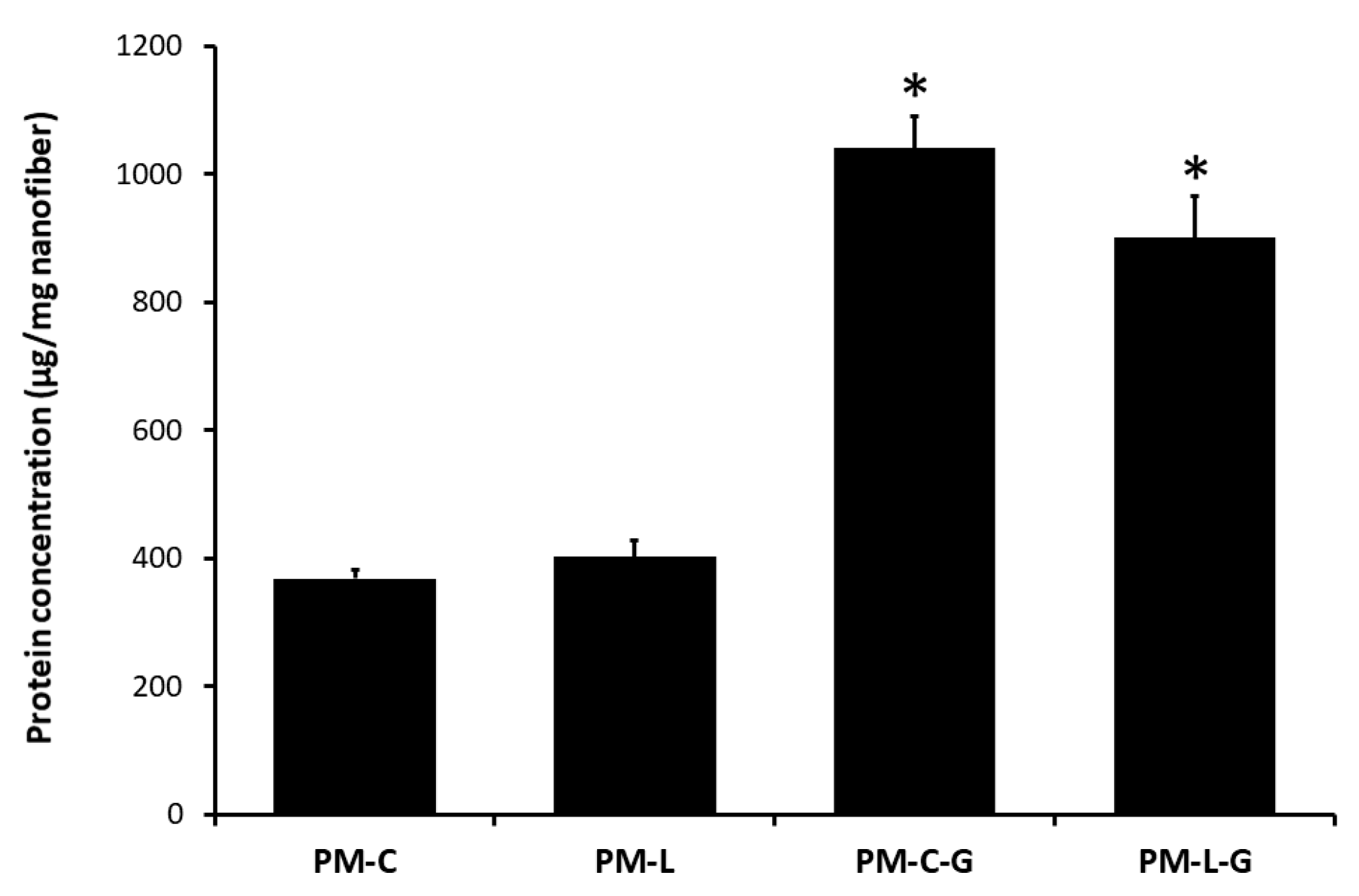

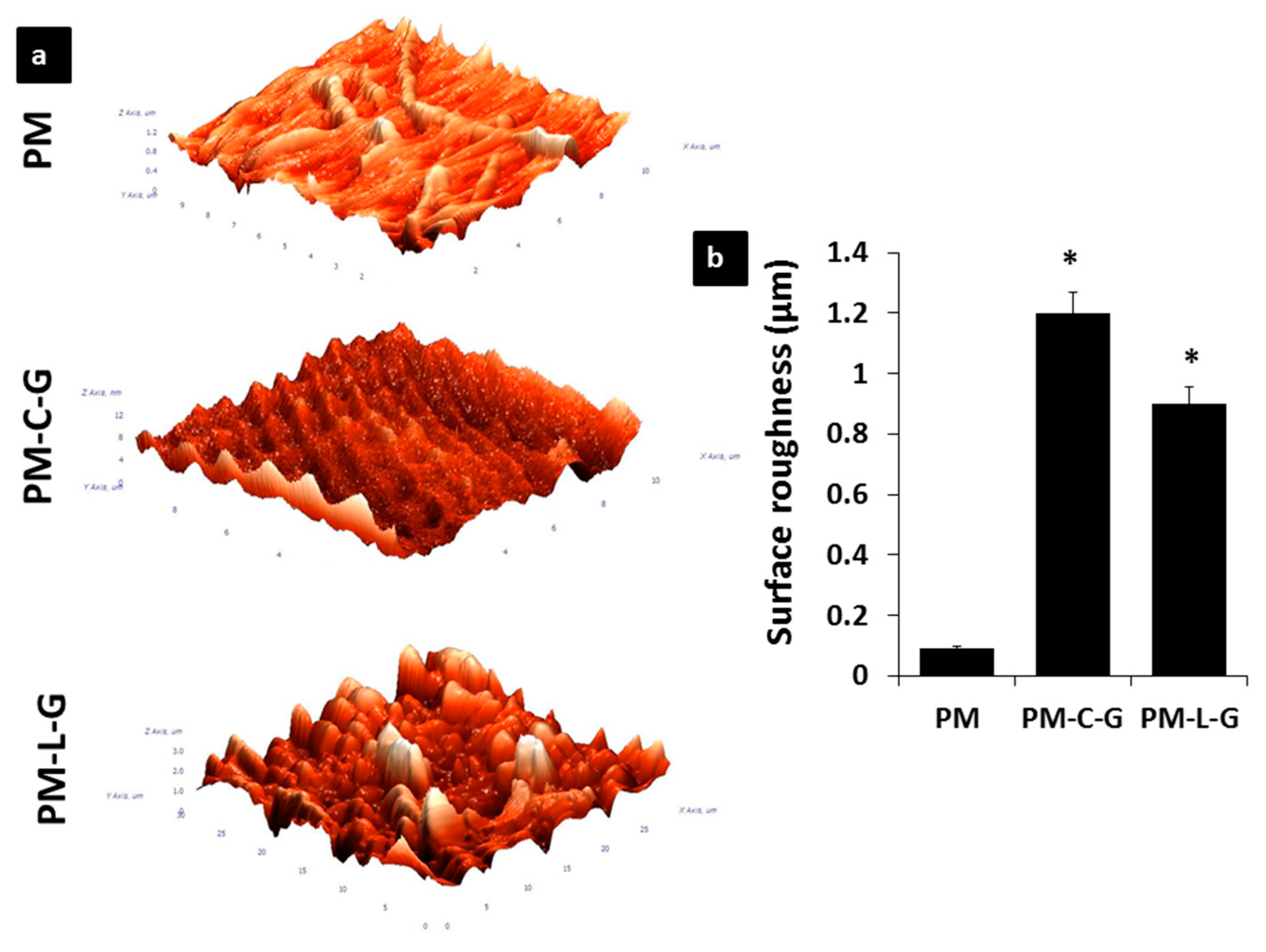
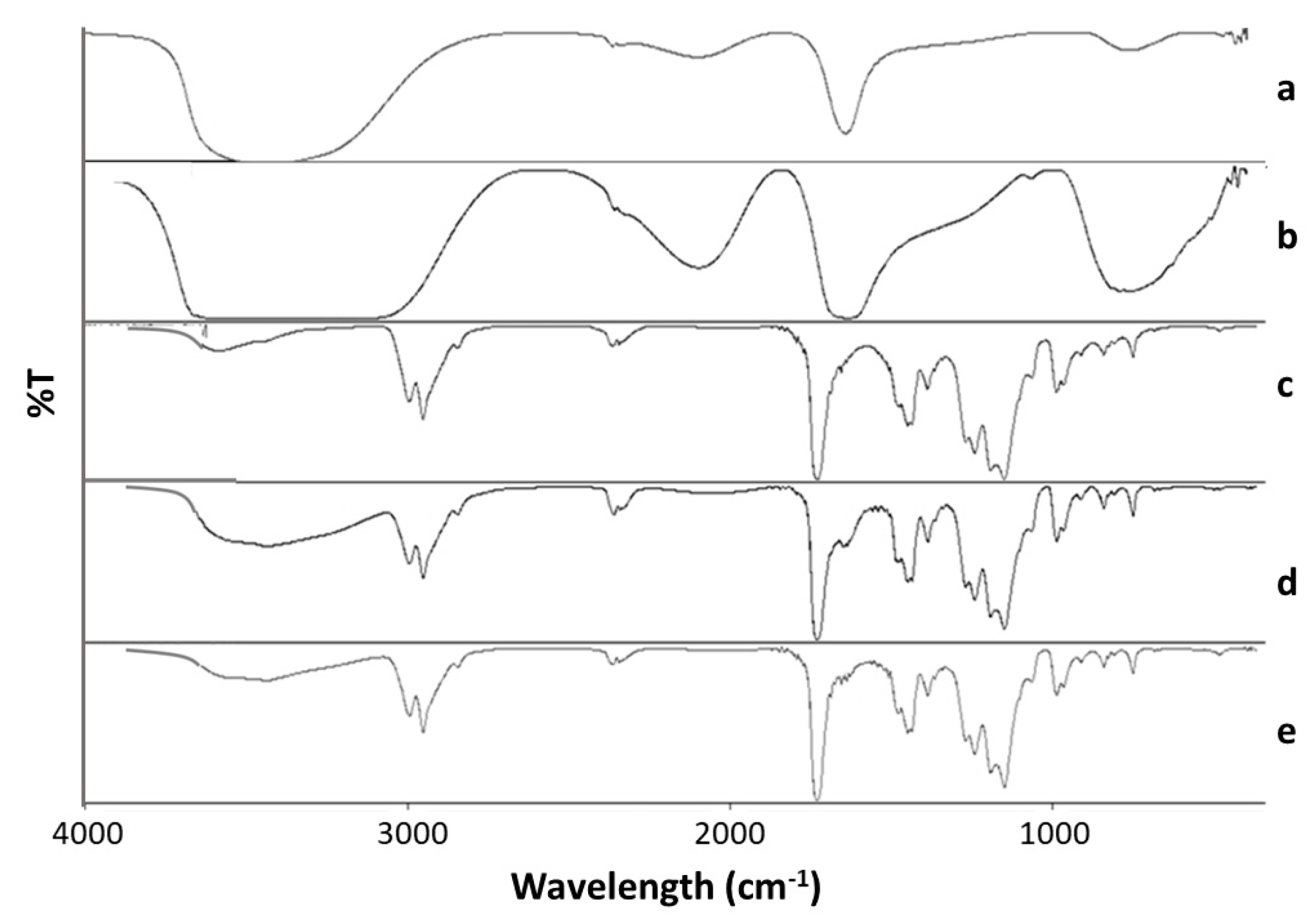
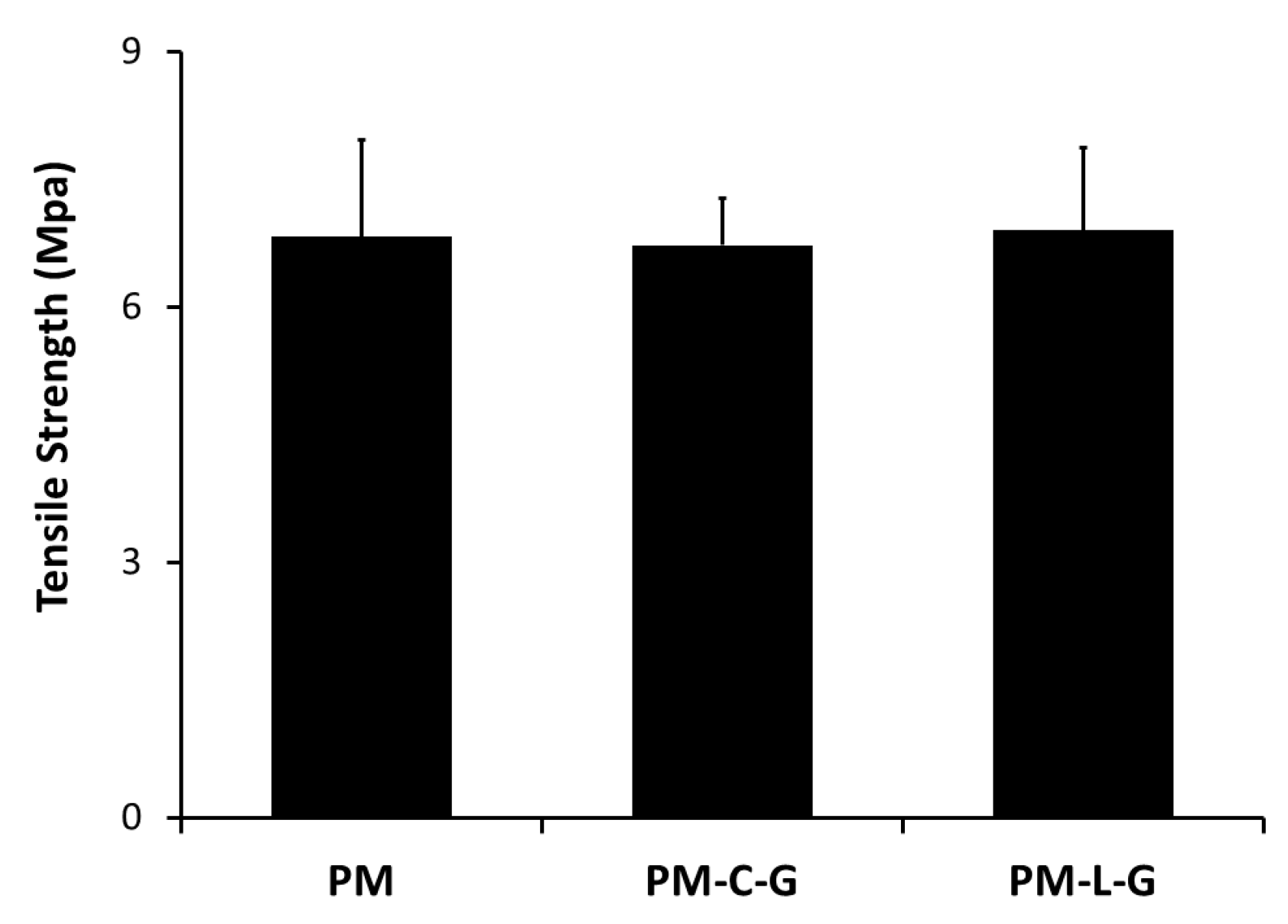
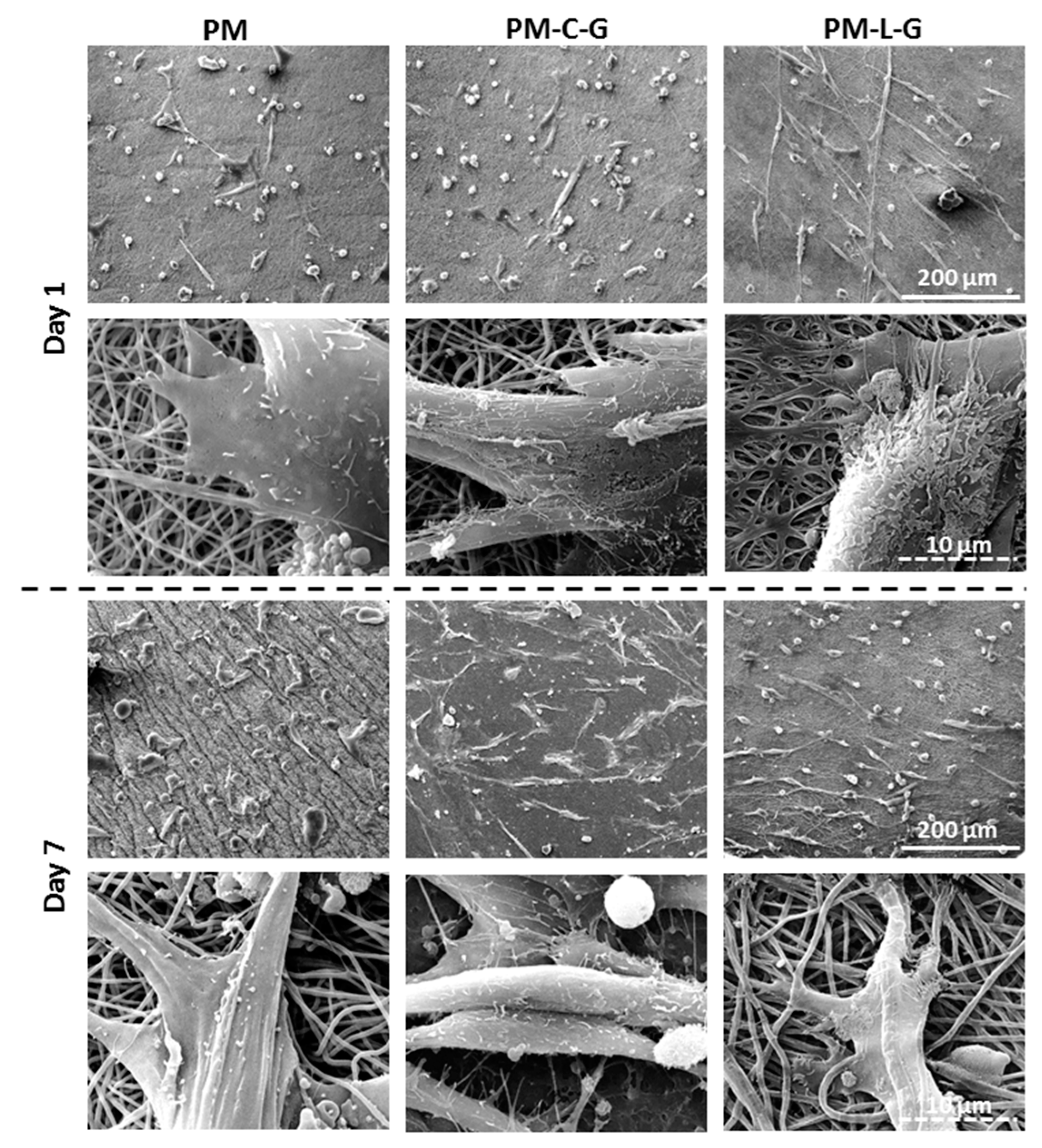

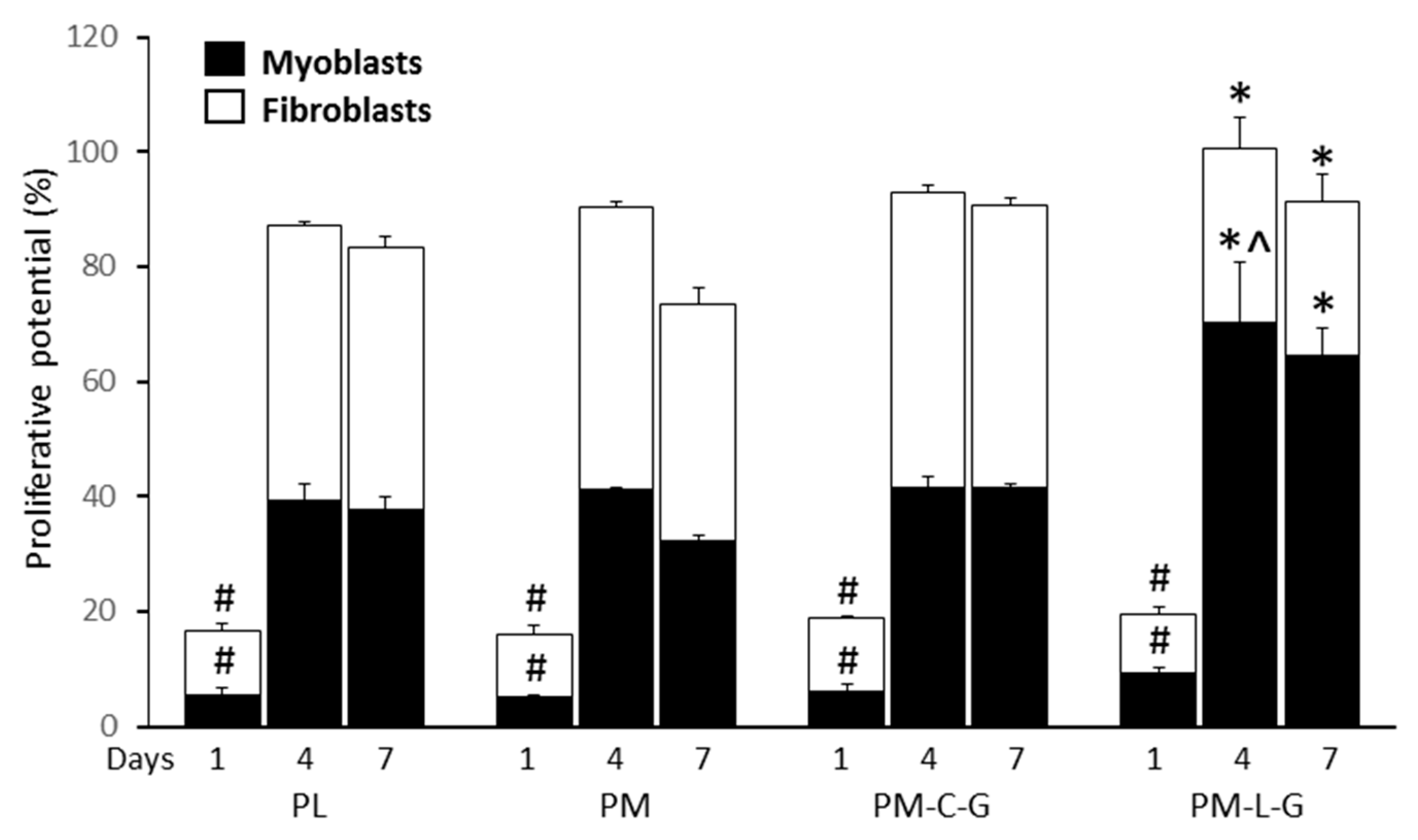
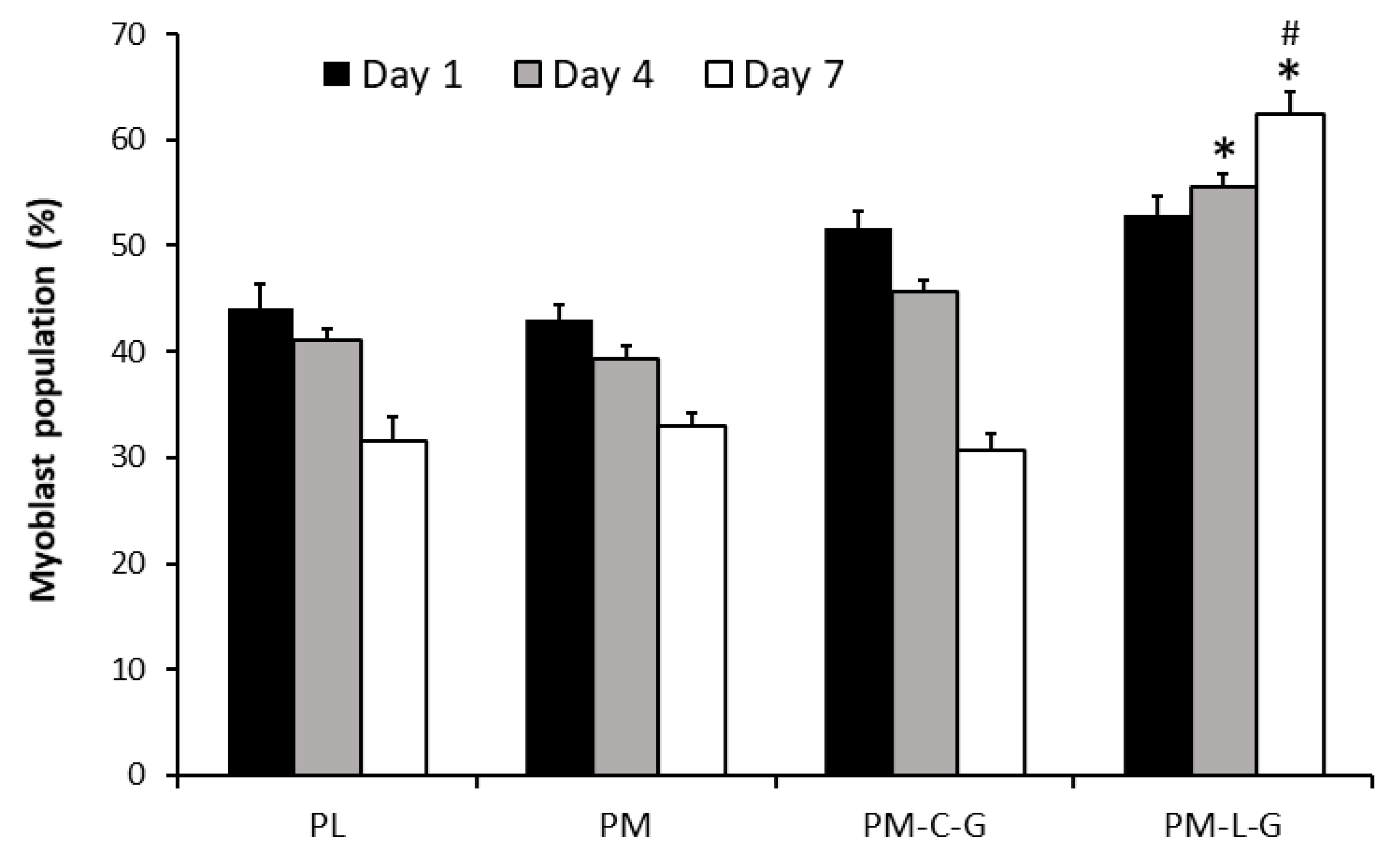

| 1° Antibody/Counterstain | Specificity | 2° Antibody |
|---|---|---|
| Anti-mouse Ki67 (1:250; Abcam, Cambridge, UK) | Nuclear protein expressed during proliferation | Alexa Fluor Goat anti-mouse 594 (1:300; Invitrogen, Carlsbad, CA, USA) |
| Anti-rabbit desmin (1:300; Novusbio, Littleton, CO, USA) | Myoblast | Alexa Fluor Goat anti-mouse 488 (1:300; Invitrogen, USA) |
| 4,6-diamidino-2-phenylindole (1:15,000; DAPI; Molecular Probes, Eugene, OR, USA) | Nuclei | Not applicable |
| Assay | Staining of Cells | Equation |
|---|---|---|
| Proliferative potential | Desmin (Myoblasts) + Ki67 (Proliferating cells) + DAPI (Nucleus) [Desmin negative cells were identified as fibroblasts] | |
| Growth rate of myoblasts and fibroblasts | Desmin (Myoblasts) + DAPI (Nucleus) [Desmin negative cells were identified as fibroblasts] | Growth rate (h−1) = ln (Xa2/Xa1)/∆t |
| Percentage of myoblasts/fibroblasts | Desmin (Myoblasts) + DAPI (Nucleus) [Desmin negative cells were identified as fibroblasts] |
© 2017 by the authors. Licensee MDPI, Basel, Switzerland. This article is an open access article distributed under the terms and conditions of the Creative Commons Attribution (CC BY) license (http://creativecommons.org/licenses/by/4.0/).
Share and Cite
Zahari, N.K.; Idrus, R.B.H.; Chowdhury, S.R. Laminin-Coated Poly(Methyl Methacrylate) (PMMA) Nanofiber Scaffold Facilitates the Enrichment of Skeletal Muscle Myoblast Population. Int. J. Mol. Sci. 2017, 18, 2242. https://doi.org/10.3390/ijms18112242
Zahari NK, Idrus RBH, Chowdhury SR. Laminin-Coated Poly(Methyl Methacrylate) (PMMA) Nanofiber Scaffold Facilitates the Enrichment of Skeletal Muscle Myoblast Population. International Journal of Molecular Sciences. 2017; 18(11):2242. https://doi.org/10.3390/ijms18112242
Chicago/Turabian StyleZahari, Nor Kamalia, Ruszymah Binti Haji Idrus, and Shiplu Roy Chowdhury. 2017. "Laminin-Coated Poly(Methyl Methacrylate) (PMMA) Nanofiber Scaffold Facilitates the Enrichment of Skeletal Muscle Myoblast Population" International Journal of Molecular Sciences 18, no. 11: 2242. https://doi.org/10.3390/ijms18112242





